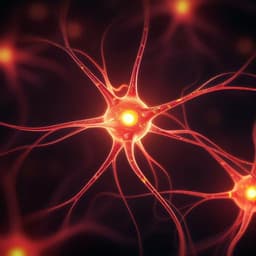
Engineering and Technology
Electro-assisted printing of soft hydrogels via controlled electrochemical reactions
A. C. D. Silva, J. Wang, et al.
Discover the groundbreaking electro-assisted printing method for creating patterned soft hydrogels, explored by Aruá Clayton Da Silva, Junzhi Wang, and Ivan Rusev Minev. This innovative approach enables precise control of hydrogel growth rates and allows for the creation of hybrid systems with potential applications in bioelectronics.
~3 min • Beginner • English
Introduction
The study addresses how to achieve precise, selectable, and controllable hydrogel gelation and patterning for bioelectronics and tissue-related applications. Hydrogels mimic soft tissue properties and offer tunable viscoelastic, swelling, bioactive, and electrical characteristics. However, integrating well-defined hydrogels into devices is challenging due to the need for tight control over polymerisation reactions and adhesion to metals or polymers. The authors hypothesise that potentiostatic control using a three-electrode configuration can enable ECC-driven gelation at defined potentials, thereby selecting specific gelation pathways (precipitation, covalent, ionic, and hybrid conductive systems) and controlling growth rates. They aim to confine reactions within droplets to pattern hydrogels directly onto conductive substrates, including flexible electronics, enabling adherent, well-defined hydrogel features suitable for biointerfaces and soft electronics.
Literature Review
Prior work has shown electrochemically triggered gelation by pH changes near electrodes, enabling electrodeposition of chitosan and ionically crosslinked alginate. Two-electrode approaches, custom 3D printers, and meniscus-confined electrodeposition (including SECCM-derived systems) have achieved spatial control but suffer from uncertain electrode potentials, limiting reaction selectivity and rate control. Layer-by-layer coatings and bioprinting via pin-art devices have expanded electro-assisted hydrogel approaches. Concurrently, conductive hydrogels (e.g., incorporating PEDOT, PPy, PANI with biopolymers like alginate, gelatin, PVA) have advanced bioelectronic interfaces, drug delivery, and electrode coatings. Yet, reliable integration with precise control over gelation chemistry and adhesion remains a gap that potentiostatic three-electrode systems could fill by providing defined potentials and kinetics based on electrochemical theory (Nernst equation and electrode kinetics).
Methodology
Overview and setup: Electro-assisted deposition is confined to a droplet bridging a conductive working electrode (WE) and a custom nozzle housing the counter electrode (CE) and an Ag/AgCl pseudoreference (RE). Operating under potentiostatic control (three electrodes) ensures well-defined WE potentials, enabling identification and exploitation of specific electrochemical steps in ECC gelation.
- Electrodes and hardware: WE was either gold foil (0.10 mm thick, 2.0×2.0 cm²) or ITO/PET (4.0×1.0 cm²). CE was the stainless-steel dispensing needle (510 µm ID, 820 µm OD, 25.4 mm length) of the printing nozzle. RE was a silver wire (0.10 mm dia, 2 cm) converted to Ag/AgCl by electrodeposition (in 3 M KCl, OCP for 300 s, then +50 mV vs OCP for 1800 s). The RE was inserted into the nozzle without contacting the CE. The nozzle’s plastic body prevents short circuits.
- Instrumentation: A portable potentiostat (PalmSens4, PSTrace 5.8) coupled to a commercial bioprinter (3DDiscovery, RegenHU) enabled in situ CV, CA, and EIS. EIS: 1 MHz–0.1 Hz, 10 mV RMS, 10 points/decade. Data fitting used a modified Randles equivalent circuit; capacitance derived from CPE via C_hydrogel = Y0^−1 (R_hydrogel ω)^(n−1).
- Pre-gel (pre-polymer) solutions:
• Chitosan (precipitated or covalent): 1% (w/v) chitosan (low Mw 50–190 kDa or high Mw 310–375 kDa; 75–85% deacetylated) in 1% (v/v) acetic acid with 0.15 M NaCl.
• Alginate (ionic): 1% (w/v) sodium alginate in water with 0.5% (w/v) CaCO3 suspended.
• PEDOT/alginate (hybrid): alginate formulation plus 70 mM SDS (to solubilize EDOT) and 50 mM EDOT.
- Procedures:
• Chitosan gelation mechanisms: Precipitation triggered by cathodic water reduction at WE (−2.0 V vs Ag/AgCl) to deplete local protons, causing chitosan deprotonation and precipitation. Covalent crosslinking at +1.8 V on gold in presence of chloride via Au oxidation to AuCl4−; AuCl4− oxidizes chitosan alcohols to aldehydes, then Schiff base formation with chitosan amines yields covalent crosslinks. Absence of chloride or non-gold WE (e.g., ITO) did not yield covalently crosslinked gels, supporting the AuCl4− pathway.
• Alginate ionic crosslinking: Anodic water oxidation at WE generates protons which react with CaCO3 to release Ca2+, then Ca2+ complexes with alginate carboxylates to form ionic crosslinks. WE potentials tested: 3, 4, and 5 V vs Ag/AgCl.
• PEDOT/alginate hybrid: Apply +1.8 V (and +3.0 V on ITO/PET for faster kinetics) to initiate EDOT electropolymerisation to PEDOT. Positive charges in PEDOT are charge-balanced by alginate (COO−), while PEDOT polymerisation-generated protons aid alginate gelation without relying on water hydrolysis. Growth monitored by CA; CV used to track PEDOT redox.
- Patterning (electro-assisted printing): The droplet footprint between nozzle and substrate defines the reaction volume. By moving the nozzle relative to the substrate during potentiostatic deposition, lines and shapes are printed. Typical parameters: nozzle travel speed 0.01 mm s−1, pre-gel flow 0.25 µL s−1, needle ID 510 µm. Maintaining a constant nozzle–substrate gap avoids open/short circuits and stabilizes droplet footprint. Patterns (lines, octagons, curves, “UoS” letters) were printed on gold. On ITO/PET, alginate at 5 V deposited for ~2 min before ITO stripping halted current; PEDOT/alginate dots and lines were deposited at +3 V without damaging ITO.
- Characterisation and quantification: CA used to relate cumulative charge density to hydrogel thickness/volume. Optical imaging (Zeiss Stemi 508; ImageJ) provided thickness, area, and volume (cylinder and spherical segment approximations). EIS with modified Randles circuits extracted hydrogel resistance and capacitance; for PEDOT/alginate, a variant circuit separated PEDOT and alginate contributions. Experiments were triplicated with freshly prepared solutions; data reported as mean ± SD unless stated.
Key Findings
- Three-electrode potentiostatic control enables selection of gelation pathways and control of growth kinetics in ECC-driven hydrogel formation within confined droplets.
- Chitosan systems:
• Precipitated chitosan at −2.0 V (cathodic water reduction) yields cloudy gels with cavities, consistent with precipitation by local pH increase.
• Covalently crosslinked chitosan at +1.8 V (vs Ag/AgCl) on gold in chloride-containing electrolyte yields clear gels. Evidence supports AuCl4−-mediated oxidation (gold oxidation in presence of Cl−), not hypochlorite: no covalent gel on ITO; absence of gas-related defects; minimal deposition without Cl− despite applying +1.8 V.
• Growth kinetics: Thickness reaches a plateau due to diffusion/mass transport limits of oxidative species through the forming gel. Charge–growth relationship in initial linear phase indicates higher efficiency for high Mw vs low Mw chitosan (about 1.6× more hydrogel per unit charge; reported growth coefficients 0.83 vs 0.52 per mC with high correlation r ≈ 0.993).
- Alginate ionic gels:
• Anodic water oxidation at WE (>~2.5 V in CV) produces protons that liberate Ca2+ from CaCO3, enabling ionic crosslinking.
• Higher WE potentials (3, 4, 5 V) increase growth rate; beyond ~0.6 mm thickness, growth slows due to mass transport/electrical passivation.
• Thickness scales with cumulative charge density with similar slopes across 3–5 V; average growth profile ≈ 0.17 mm³ mC−1.
- PEDOT/alginate hybrid:
• Applying +1.8 V initiates EDOT polymerisation (current increases starting ~+1.7 V in CV); droplet turns dark blue over minutes; area coverage reached in ~6 min. CA current decreases after ~6 min, consistent with monomer depletion.
• CV after cycling shows PEDOT features (oxidation ~+0.35 V, reduction ~−0.45 V) and an emerging ~+1.25 V peak (polymerisation of free EDOT on PEDOT).
• EIS (modified Randles model): Alginate hydrogels show increasing resistance and capacitance with deposition potential: at 3 V, Rhydrogel ≈ 0.83 Ω·m², Chydrogel ≈ 23.74 µF; at 4 V, 0.94 Ω·m² and 48.31 µF; at 5 V, 4.72 Ω·m² and 26.10 µF. PEDOT/alginate shows markedly enhanced conductivity: total Rhydrogel ~0.84 Ω·m² with higher capacitance (~101 µF). Deconvolution suggests PEDOT contribution Rhydrogel ~0.200 Ω·m² and Chydrogel ~0.54 µF.
- Patterning and adhesion:
• Successful printing of lines, octagons, curves, and “UoS” letters on gold; line widths ~5.7 mm (chitosan, +1.8 V) and ~4.5 mm (alginate, 5 V) using 510 µm ID needle, speed 0.01 mm s−1, flow 0.25 µL s−1.
• On ITO/PET: alginate at 5 V deposits for ~2 min but strips ITO due to gas; PEDOT/alginate dots printed at +3 V avoid ITO damage. Average charge per dot 45.8 ± 5.3 mC (n=10). Dots adhere under bending; continuous lines also feasible.
- Temporal scales: Chitosan and alginate gels can cover the droplet footprint in ~10 s; PEDOT/alginate requires ~6 min due to chain growth and monomer diffusion limits.
Discussion
The results demonstrate that introducing potentiostatic control via a three-electrode configuration solves a key limitation of prior two-electrode hydrogel electrodeposition: uncertainty in electrode potential and reaction selectivity. By operating at defined potentials, the authors selectively trigger distinct ECC pathways enabling precipitation (chitosan), covalent crosslinking (chitosan via AuCl4−), ionic crosslinking (alginate via Ca2+ release), and hybrid conductive gel formation (PEDOT/alginate). Quantitative correlations between charge and gel thickness/volume confirm controllable growth, with identifiable diffusion and passivation limits at larger thicknesses. Electrical characterisation via EIS shows that incorporating PEDOT into alginate substantially improves conductivity and charge transfer, highlighting the feasibility of creating functional conductive hydrogels tailored for bioelectronic interfaces. Spatial confinement to droplets, combined with motion control from a 3D printer, enables straightforward 2D patterning on both rigid (gold) and flexible (ITO/PET) substrates, with adherent features and pattern versatility. Collectively, the approach advances precise integration of hydrogels with electronics, addressing adhesion and patterning while preserving mild, aqueous processing conditions suitable for biointerfaces.
Conclusion
This work establishes electro-assisted, potentiostatically controlled droplet-confined hydrogel deposition as a versatile method to select and control gelation pathways (precipitated, covalent, ionic) and fabricate hybrid conductive hydrogels (PEDOT/alginate). The three-electrode configuration enables operation at defined potentials, quantitative control of growth via charge, and in situ electrochemical characterisation. The method integrates with commercial 3D printing to pattern adherent hydrogels on gold and flexible ITO/PET substrates, demonstrating practical routes for bioelectronics and soft devices.
Future directions include: extending to other polymers and crosslinking chemistries; optimizing nozzle geometry, flow, and substrate surface energy for finer features; scaling to 3D structures; integrating living cells or bioactive cues; enhancing throughput and multi-material printing; and engineering device architectures (e.g., electrode arrays, drug delivery coatings) leveraging tailored electrical and mechanical properties.
Limitations
- Covalently crosslinked chitosan relies on gold and chloride for AuCl4− formation; it did not form on ITO or in chloride-free conditions, limiting substrate and electrolyte choices.
- Growth plateaus and slows as gels thicken due to mass transport limitations and electrical passivation, constraining maximum thickness in a single step.
- Two-electrode approaches lack precise potential control; while not used here, it underscores the necessity of three-electrode setups and may limit compatibility with simpler hardware.
- On ITO/PET, alginate deposition via water hydrolysis can strip the thin ITO layer due to gas evolution, restricting process time (~2 min) and substrate durability; alternative conditions (e.g., PEDOT/alginate without water hydrolysis) are needed.
- Printing parameter optimisation (line width, droplet control, speed/flow) and comprehensive mechanical/biological characterisation were beyond scope, affecting immediate application tuning and generalizability.
Related Publications
Explore these studies to deepen your understanding of the subject.







